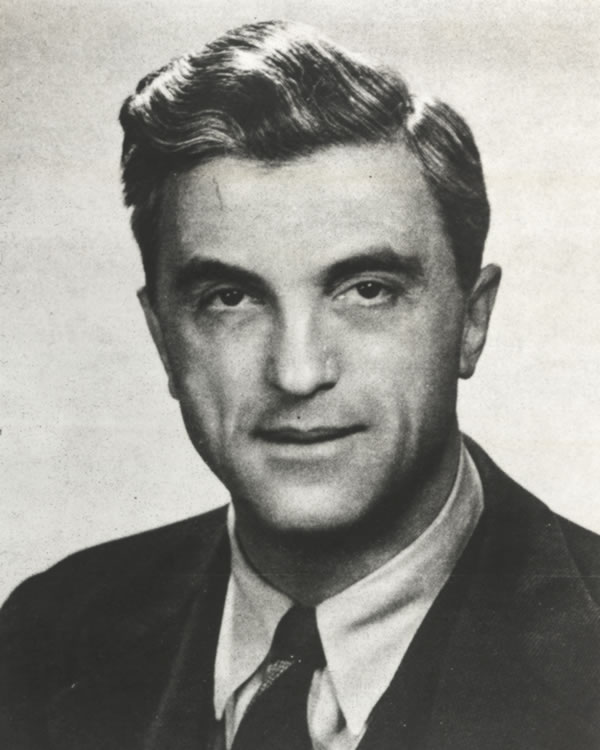Felix Bloch (1905–1983)
Professor of physics

Felix Bloch was born in Zurich on 23 October 1905 to the Jewish businessman Gustav Bloch and his wife Agnes.
After leaving school, he embarked on a degree in engineering at ETH Zurich in 1924 before switching to the Department of Mathematics and Physics one year later. At a time of his degree, important groundwork was being laid for quantum physics in Zurich. As a student, he attended lectures by Peter Debye, Paul Scherrer and Hermann Weyl, and seminars by Erwin Schrödinger, who was researching wave mechanics at the University of Zurich's Physics Institute and showcased his famous wave equation for the hydrogen atom for the first time in 1926.
Doctorate and years as assistant
In November 1927 Bloch moved to the University of Leipzig and, at the age of 22, began a dissertation under Werner Heisenberg, who was only four years his senior and whom he soon befriended. As Heisenberg's first doctoral student, he followed his advice and studied the movement of electrons in periodical lattice potential and the resulting conductivity in his thesis entitled "Über die Quantenmechanik der Elektronen in Kristallgittern", thereby paving the way for his subsequent fame. After completing his doctorate, he returned to ETH Zurich for a year at the end of 1928 as an assistant to Wolfgang Pauli before taking up assistantships under Adriaan Fokker and Hendrik A. Kramers in Holland. In 1930 Bloch returned to the University of Leipzig as a senior assistant of Heisenberg's, where he became a professor the following year with his paper "Zur Theorie des Austauschproblems und der Remanenzerscheinung der Ferromagnetica". In the meantime, he also conducted research at Niels Bohr's institute in Copenhagen.
Emigration to the USA
The seizure of power by the Nazis and especially the "Gesetz zur Wiederherstellung des Berufsbeamtentums" (Civil Service Restoration Act) passed in April 1933 put an abrupt end to the collaboration between Bloch and Heisenberg. The strict implementation of the law by the education ministry responsible forced Bloch to abandon his position as a physicist at the University of Leipzig against his and Heisenberg's will in May 1933 and leave Germany for Switzerland. A few months later, he left Europe altogether and emigrated to the USA in 1934 to take up a professorship at Stanford University. The change in continent was also mirrored by a scientific change of tack. He began to move away from his more theoretical focus and increasingly towards experimental physics. His research primarily concentrated on the magnetism of atomic cores and their components, protons and – only discovered in 1932 – neutrons.
Collaboration on the Manhatten-project and on the radar-project
During the war, he suspended his teaching and research activities and worked on the Manhattan Project headed by the physicist Robert Oppenheimer. In June 1942 he attended a summer seminar organised by Oppenheimer in Berkeley, where leading scientists of the day examined the possibilities of building a uranium bomb. From early summer 1943 he participated in the construction of the atomic bomb at the secret research centre at Los Alamos. For reasons that were never fully explained, he left the project again in the autumn of 1943 and joined Harvard University's radar project until 1945. At the same time, back in Germany his former teacher Werner Heisenberg was involved in the uranium project of the Heereswaffenamt (German Army Weapons Agency).
Awarding the Nobel Prize
After the war, Bloch returned to Stanford and presented a paper on nuclear induction, a method that enables the measurement of the magnetic moment of atomic cores, in July 1946. The discovery earned him and Edward Mills Purcell the Nobel Prize for Physics in 1952. Bloch's research thus made a key contribution towards the basics of nuclear magnetic resonance imaging, enabling the determination of nuclear moments and thus greatly aiding the development of modern aids for structural determination or medical diagnostics.
Return to Switzerland and death
Between 1954 and 1955, Bloch briefly ran CERN in Geneva as its first Director-General. For professional and family reasons, however, he soon returned to Stanford, where he worked until his retirement. He died of a heart attack in Zurich on 10 September 1983.
Bloch's life entered the realms of literature in the novel "Der Fälscher, die Spionin und der Bombenbauer" by Swiss author Alex Capus published in 2013.
Manuscript

Holdings
Besides Felix Bloch’s student register, the ETH Zurich University Archives contain individual letters penned by the scientist in various personal papers. The Biographical Dossier provides further information on Bloch’s life and work, and there are also references to Bloch’s work at ETH Zurich in the university’s historical administrative files, which are also held in the University Archives.
All Nobel Prize laureates of ETH Zurich at a glance